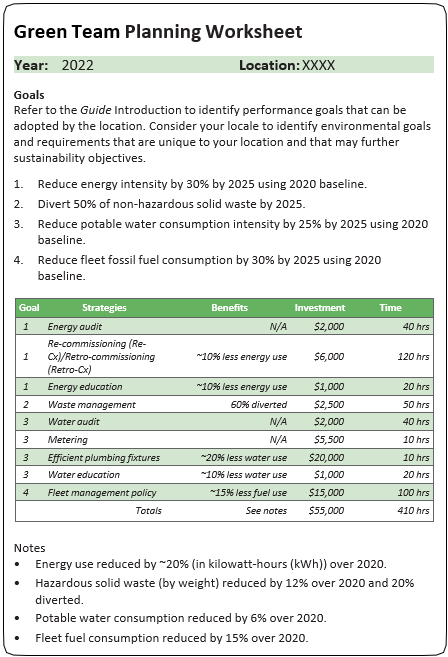Keys to Green Team Success
There are several best management practices that can help Green Teams manage expectations of mission leaders, inspire post personnel, advocate change, and contribute to success.
Following are the key actions to success gleaned from experienced Green Teams:
-
- Gain knowledge of site’s context.
Green Teams should be aware of, and understand as well as possible, the contexts within which they operate. The quality of the information maintained by the team can determine the level of certainty with which the teams can execute change.
In order to better understand system characteristics—including existing conditions; geographic context; climate; and financial, time, and policies constraints—Green Teams can undertake the following tasks:
- Conduct audits for each of the Guide’s impact areas.
- Discuss audit results as a team.
- Identify areas of special interest and priority to post, such as local climates, resource availability, and resource costs.
- Identify Green Team and post constraints, such as budgets and key team member availability to contribute and complete strategies. Include short-, mid-, and long-term constraints.
- Select meaningful strategies.
There is no one-size-fits-all approach to achieving performance improvements at facilities. Some sites may have significant impacts related to energy and water consumption, while other sites’ biggest impacts may be related to their transportation profiles. Sites should use the Guide to identify their top two or three impact areas and focus on those areas first to gain momentum and success. To bring focus to those top-priority impact areas, Green Teams should begin with audit and staff engagement strategies; doing so can give teams greater understanding of the issues related to those topics and help them begin to shift occupant behavior toward achieving sustainable performance goals.
Begin by reading the impact area introductions, using site’s unique characteristics to rank the impact areas from most significant to least. Next, use the audit results and Priority Selection Criteria included in each impact area’s introduction to identify the two to three strategies within the highest ranked impact areas to implement. Consider which strategies can be implemented by the skills of Green Team members, and which can create operational savings with quick payback.
Although many potential strategies are included in the Guide, it does not provide an exhaustive list of strategies for meeting any goal. There are other possible strategies beyond what is written within. Seek unique opportunities to motivate others and produce results.
- Develop an implementation plan.
Strategies provided in the Guide do not provide all the information that Green Teams need to create an implementation plan; however, teams can use the Investment and Time metrics contained within each strategy as starting points for discussion. In the implementation plan, Green Teams should identify which strategies can be executed in the short term so that the team can begin to develop patterns of success. Include, too, strategies that span multiple years and achieve significant benefit.
While various levels of detail are possible, at minimum, plans should:
- Record the goals and targets.
- Establish current baselines for performance to measure against progress and success.
- Document the selected strategies and how they reinforce established goals. Use worksheet planning tools to document the planning processes.
- Document and verify progress, success, and barriers to implementation. See Green Team Planning Worksheet below for an example of how Green Teams might document their plan.
- Incorporate lessons learned and modify the plan accordingly.
- Implement, measure, and communicate results.
Successful implementation, good project management, measurement and reporting of progress, and tracking progress against project goals are activities that are critical to a Green Team’s success.
Some activities unique to Green Teams include the following:
-
- Start a Green Team webpage. Websites can be an excellent way to share success stories, gain feedback, and raise awareness.
- Connect with other site Green Teams. The strategies contained within the Guide are a compilation of those that have been successfully implemented at other organizations around the world. Consider documenting your experiences in implementing strategies—perhaps using a format similar to the one used in the Guide—and sharing information with sites in neighboring countries.
- Apply for awards, whether internally, or from national, state, local governments, or other foundations.
-
- Gain knowledge of site’s context.
Sample Green Team Planning Worksheet


